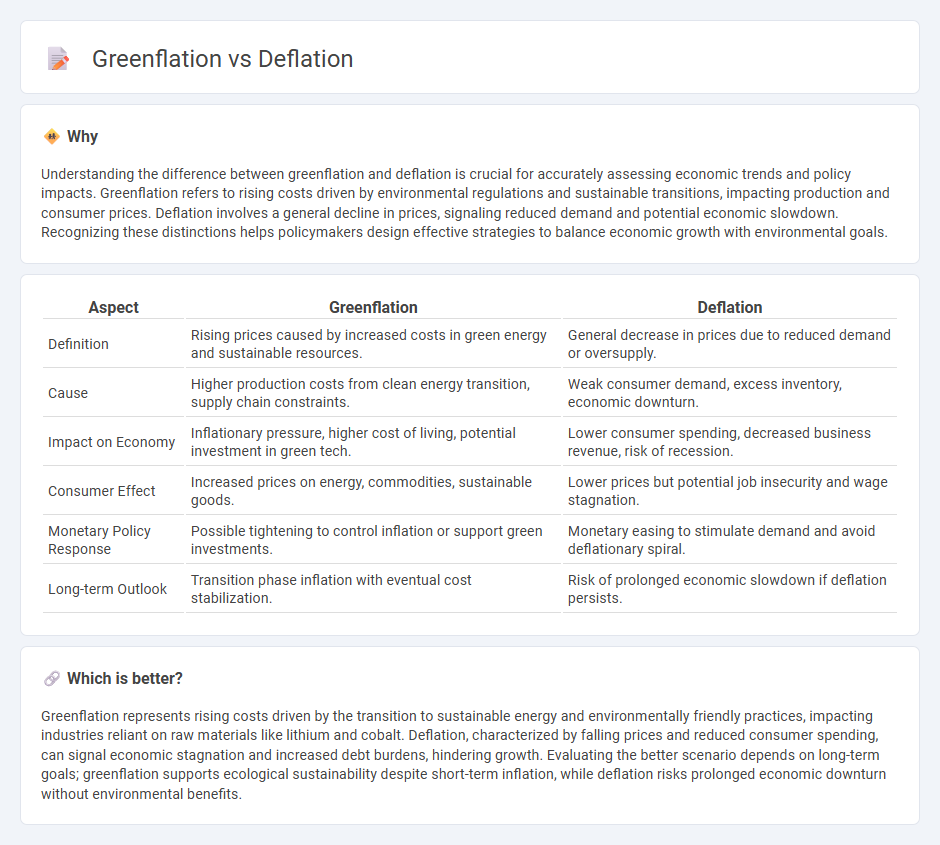
Greenflation refers to rising prices driven by increased demand and costs associated with environmentally friendly technologies and sustainable energy sources, impacting inflation rates worldwide. Deflation, conversely, is characterized by a general decline in prices, often signaling reduced consumer spending and economic slowdown. Explore how greenflation and deflation shape current economic policies and market trends.
Why it is important
Understanding the difference between greenflation and deflation is crucial for accurately assessing economic trends and policy impacts. Greenflation refers to rising costs driven by environmental regulations and sustainable transitions, impacting production and consumer prices. Deflation involves a general decline in prices, signaling reduced demand and potential economic slowdown. Recognizing these distinctions helps policymakers design effective strategies to balance economic growth with environmental goals.
Comparison Table
| Aspect | Greenflation | Deflation |
|---|---|---|
| Definition | Rising prices caused by increased costs in green energy and sustainable resources. | General decrease in prices due to reduced demand or oversupply. |
| Cause | Higher production costs from clean energy transition, supply chain constraints. | Weak consumer demand, excess inventory, economic downturn. |
| Impact on Economy | Inflationary pressure, higher cost of living, potential investment in green tech. | Lower consumer spending, decreased business revenue, risk of recession. |
| Consumer Effect | Increased prices on energy, commodities, sustainable goods. | Lower prices but potential job insecurity and wage stagnation. |
| Monetary Policy Response | Possible tightening to control inflation or support green investments. | Monetary easing to stimulate demand and avoid deflationary spiral. |
| Long-term Outlook | Transition phase inflation with eventual cost stabilization. | Risk of prolonged economic slowdown if deflation persists. |
Which is better?
Greenflation represents rising costs driven by the transition to sustainable energy and environmentally friendly practices, impacting industries reliant on raw materials like lithium and cobalt. Deflation, characterized by falling prices and reduced consumer spending, can signal economic stagnation and increased debt burdens, hindering growth. Evaluating the better scenario depends on long-term goals; greenflation supports ecological sustainability despite short-term inflation, while deflation risks prolonged economic downturn without environmental benefits.
Connection
Greenflation and deflation are connected through their impact on purchasing power and price stability in the economy. Greenflation arises from increased costs of adopting environmentally sustainable practices, leading to higher prices for goods and services, while deflation involves a general decline in prices often caused by reduced demand or technological advancements. The intersection occurs when greenflation pressures are counteracted by deflationary forces, influencing overall inflation rates and economic growth dynamics.
Key Terms
Price Level
Deflation represents a general decline in the price level across the economy, often signaling reduced consumer demand and economic slowdown. Greenflation, by contrast, refers to rising prices driven specifically by the costs associated with transitioning to environmentally sustainable technologies and energy sources. Explore further to understand how these price level dynamics impact economic policy and market behavior.
Environmental Regulation
Environmental regulation drives greenflation by increasing production costs through stricter emissions standards and renewable energy mandates, while deflation typically results from overall reduced demand or technological advancements lowering costs. Greenflation specifically affects sectors investing in sustainable technologies, causing price rises despite efforts to curb inflation. Explore how evolving environmental policies shape these economic trends for a deeper understanding.
Production Costs
Deflation typically lowers production costs as falling prices reduce input expenses, whereas greenflation increases production costs due to investments in sustainable materials and environmentally friendly technologies. The shift towards green energy and stricter environmental regulations often drives up expenses in raw materials and compliance, impacting overall manufacturing budgets. Explore how these contrasting trends influence industries and strategies for managing evolving production costs.
Source and External Links
Deflation - Definition, Causes, Effects, Impact - Deflation is a persistent decrease in the general price level of goods and services, often caused by a fall in aggregate demand or an increase in aggregate supply, and can intensify economic downturns by discouraging spending and investment.
Deflation | EBSCO Research Starters - Deflation is characterized by a decline in the supply of money or credit, leading to lower prices, and while it may seem beneficial to consumers initially, it typically signals deeper economic problems such as recession or depression.
Deflation - Wikipedia - Deflation occurs when the inflation rate becomes negative, increasing the value of currency over time, and can lead to reduced economic activity as consumers delay purchases, potentially creating a deflationary spiral.
 dowidth.com
dowidth.com